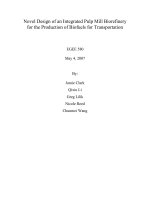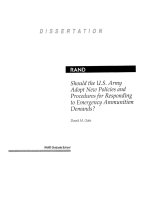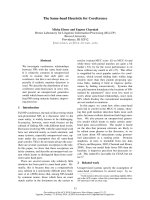Going to the Mines to look for Diamonds pot
Bạn đang xem bản rút gọn của tài liệu. Xem và tải ngay bản đầy đủ của tài liệu tại đây (2.29 MB, 158 trang )
Ronald D. Fricker, Jr.
C. Christine Fair
Prepared for the Office of the Secretary of Defense
R
National Defense Research Institute
Approved for public release; distribution unlimited
Experimenting with
Military Recruiting Stations in Malls
The research described in this report was sponsored by the Office of
the Secretary of Defense (OSD). The research was conducted in
RAND’s National Defense Research Institute, a federally funded
research and development center supported by the OSD, the Joint
Staff, the unified commands, and the defense agencies under
Contract DASW01-01-C-0004.
RAND is a nonprofit institution that helps improve policy and
decisionmaking through research and analysis. RAND
®
is a
registered trademark. RAND’s publications do not necessarily reflect
the opinions or policies of its research sponsors.
© Copyright 2003 RAND
All rights reserved. No part of this book may be reproduced in any
form by any electronic or mechanical means (including
photocopying, recording, or information storage and retrieval)
without permission in writing from RAND.
Published 2003 by RAND
1700 Main Street, P.O. Box 2138, Santa Monica, CA 90407-2138
1200 South Hayes Street, Arlington, VA 22202-5050
201 North Craig Street, Suite 202, Pittsburgh, PA 15213-1516
RAND URL: />To order RAND documents or to obtain additional information,
contact Distribution Services: Telephone: (310) 451-7002;
Fax: (310) 451-6915; Email:
Library of Congress Cataloging-in-Publication Data
Fricker, Ronald D., 1960-
Going to the mines to look for diamonds: experimenting with recruiting stations
in malls / Ronald D. Fricker, Jr., C. Christine Fair.
p. cm.
“MR-1697.”
Includes bibliographical references.
ISBN 0-8330-3443-X (pbk.)
1. United States—Armed Forces—Recruiting, enlistment, etc.—Evaluation. 2.
Shopping malls—United States. I. Fair, C. Christine. II.Title.
UB323.F74 2003
355.2'23'0973—dc22
2003015007
Cover design by Barbara Angell Caslon
Cover photograph courtesy of Ronald D. Fricker, Jr.
iii
PREFACE
In 1999, with the intention of improving the process by which the
United States armed forces recruit youth to join the military services,
the Joint Recruiting Facilities Committee recommended the
development and establishment of a new type of recruiting station:
the marketing-enhanced recruiting station (MERS). The goal was to
employ the MERS in support of actual recruiting operations while
also using it to raise awareness in the general public of the military
services as employment and career opportunities. To accomplish
this goal, the marketing-enhanced recruiting stations concept com-
bines both marketing and recruiting operations in a single facility, to
be located in high-foot-traffic locations, such as large regional malls.
The MERS was envisioned to be an upgraded recruiting station,
complete with special “marketing enhancements”—television and
video monitors for playing U.S. armed forces’ advertisements, a
computer kiosk enabling access to military web sites, and other
“high-tech” features—that would present an inviting image of the
military to youth and the adults who may influence their enlistment
decisions (“influencers”). It would entice the youth and their influ-
encers to enter the facility, expose them to the positive aspects of
military service, and facilitate their exploration of the available op-
portunities.
In early 2000, the Under Secretary of Defense for Personnel and
Readiness authorized the construction of a prototype marketing-
enhanced recruiting station in the Potomac Mills Mall located in
northern Virginia. That MERS began operation in December 2000
with the expectation that 30 additional MERS would be opened
iv Going to the Mines to Look for Diamonds
subsequently throughout the country. However, before proceeding
further, the Department of Defense decided first to formally evaluate
the Potomac Mills station’s performance. RAND was asked to
conduct the evaluation.
This report summarizes the results of that evaluation. It includes (1)
statistical information about the performance of the Potomac Mills
station; (2) information about how the services used the station, in-
cluding employment of civilian administrators; (3) conclusions about
the potential of the MERS concept in general, as well as ways in
which this particular station might be improved; (4) case studies of
standard recruiting stations located in other retail malls; and (5) rec-
ommendations about how the services and the Office of the Secre-
tary of Defense might utilize this prototype station to experiment fur-
ther with and learn about the effectiveness of various recruiting
practices and techniques.
Because this evaluation is based on only one station, the results are
not predictive of the overall success or failure of the general MERS
concept, since it cannot account for how other marketing-enhanced
recruiting stations would perform in other parts of the country or
under other conditions. Instead, these results indicate how one
MERS performed under one set of operating conditions and recruit-
ing policies. However, this report is able to provide some insight into
how the MERS concept could be modified in the future for improved
performance.
This research should be of interest to the Office of the Secretary of
Defense, particularly the Office of the Under Secretary of Defense
(Personnel and Readiness); the services’ recruiting commands and
commanders; the various committees and joint councils that over-
see, coordinate, and manage military recruiting (including the Joint
Recruiting Facilities Committee, the Midlevel Interservice Recruit-
ment Committee, the Accession Oversight Council, and the Joint Ac-
cession Group); and individual recruiters and researchers interested
in recruiting issues and initiatives.
This research was originally sponsored by the Assistant Secretary of
Defense (Force Management Policy) and was conducted within the
Forces and Resources Policy Center of RAND’s National Defense Re-
search Institute (NDRI). NDRI is a federally funded research and de-
Preface v
velopment center sponsored by the Office of the Secretary of De-
fense, the Joint Staff, the unified commands, and the defense agen-
cies.
Comments on this research are welcome and may be addressed to
Ron Fricker, For more information on RAND’s
Forces and Resources Policy Center, contact the director, Susan
Everingham, , 310-393-0411, extension
7654.
vii
CONTENTS
Preface iii
Figures xi
Tables xiii
Summary xv
Acknowledgments xxv
Acronyms xxvii
Chapter One
INTRODUCTION 1
Recruiting Stations and the Recruiting Process 3
Marketing-Enhanced Recruiting Stations 7
Recruiters’ Opinions About Recruiting Stations 9
Study Design Limitations 10
Organization of This Report 12
Chapter Two
THE PROTOTYPE MARKETING-ENHANCED
RECRUITING STATION AT POTOMAC MILLS MALL 13
Potomac Mills Mall 15
Station Location in the Mall 15
Potomac Mills Recruiting Station Design and Layout 16
Rationale for Choosing This Design 19
Unique Features of This Design 20
Conclusions 24
viii Going to the Mines to Look for Diamonds
Chapter Three
HOW THE POTOMAC MILLS PROTOTYPE MERS
IS USED 27
Station Operation and Staffing 27
How Did the Services Use the Station? 29
When Were the Recruiters Present in the Station? 30
Mall Management 31
Who Is Visiting the Potomac Mills Recruiting Station? 32
Demographics 32
How Visitors Used the Station 35
What Did Visitors Think of the Various Parts of the
Station? 35
Conclusions 46
Chapter Four
POTOMAC MILLS RECRUITING STATION PRODUCTION
AND COST-EFFECTIVENESS 51
Contract-Generation Performance 52
Lead-Generation Performance 57
Potomac Mills Construction and Operating Costs 57
Enlistment Contract Production Cost-Effectiveness 58
Approaches to Improving Contract-Production Cost-
Effectiveness 60
Considering Advertising and Marketing as Part of Station
Cost-Effectiveness 63
Conclusions 67
Chapter Five
QUALITATIVE COMPARISONS WITH SIMILAR
RECRUITING STATIONS 69
Eagle Ridge Mall 70
Description of the Recruiting Station 70
Evaluating the Recruiters’ Experience 71
Mall Management 72
Mall of America 73
Description of the Recruiting Station 74
Evaluating the Recruiters’ Experience 74
Mall Management 76
Westmoreland Mall 76
Description of the Recruiting Station 77
Evaluating the Recruiters’ Experience 77
Contents ix
Mall Management 78
Galleria Mall 78
Description of the Recruiting Station 79
Evaluating the Recruiters’ Experience 79
Mall Management 81
Times Square 81
Description of the Recruiting Station 81
Evaluating the Recruiters’ Experience 82
Conclusions 83
Chapter Six
DISCUSSION AND RECOMMENDATIONS 87
What Have We Learned from the Prototype Marketing-
Enhanced Recruiting Station? 87
Discussion of the Recruiting Process’s Role in Evaluating
MERS 90
“Made Mission, Gone Fishin’” 90
Improvement Requires More Than New Hardware 92
Recommendations 93
Mining for Diamonds 98
Appendix: RAND Military Career Center Evaluation 99
Bibliography 103
xi
FIGURES
1.1. A Standard Joint Recruiting Facility (Corner of Santa
Monica Boulevard and 14th Street, Santa Monica,
Calif., April 2002) 5
1.2. A Standard Coast Guard Recruiting Station (Santa
Monica Boulevard, Santa Monica, Calif., April 2002) 6
2.1. Station Location Within the Potomac Mills Mall,
2001 16
2.2. The Entrance and Lobby of the Potomac Mills
Station 17
2.3. Plan View of Station First Floor 18
2.4. Plan View of Station Second Floor 18
3.1. Average Potomac Mills MERS Recruiter Presence by
Day for Each Hour During the Month of May 2001 30
3.2. Average Potomac Mills MERS Recruiter Presence by
Day for Each Hour During the Month of December
2001 31
3.3. Total Number of Visitors to the Potomac Mills Station
in the Year After the Station Opened, January Through
December 2001 34
3.4. Map of Virginia Zip Codes, Shaded by Fraction of
Station Visitors 36
3.5. Potomac Mills MERS Visitors, by Day of the Week 37
3.6. Time of the Day for Visitors, for Monday, Tuesday,
and Wednesday 38
3.7. Time of the Day for Visitors, for Thursday and
Friday 38
3.8. Time of the Day for Visitors, for Saturday and
Sunday 39
xii Going to the Mines to Look for Diamonds
3.9. Answers to the Prompt “‘I found the Military Career
Center . . .’ (check all that apply)” 41
3.10. Answers to the Prompt “‘The Military Career Center
Was . . .’ (pick one)” 41
3.11. Answers to the Prompt “‘The Military Career Center
was useful for . . .’ (check all that apply)” 42
3.12. Answers to the Question “‘What brought you into the
Military Career Center?’ (check all that apply)” 43
3.13. Answers to the Question “‘How did you hear about
the Military Career Center?’ (check all that apply)” 44
Photo Plates Before 45
3.14. Answers to the Prompt “‘The best feature of the
Military Career Center was . . .’ (pick one)” 45
3.15. Answers to the Prompt “‘After visiting the Career
Center, I am . . .’ (pick one)” 45
4.1. Average Contract Production for Potomac Mills
Recruiters, per Recruiter per Quarter by Service 54
xiii
TABLES
1.1. “To what extent do you agree or disagree with the
following statements about your office?” 10
1.2. “DoD is evaluating putting recruiting stations in large
enclosed malls . . . How much do you agree or
disagree with the following statements?” 11
3.1. Recruiter Staffing by Service for the First Year (2001)
of Station Operation 28
3.2. Comparison of Demographics Among MERS Visitors,
Potomac Mills Mall Visitors, and the Surrounding
Counties 33
3.3. What Visitors Do in the Potomac Mills Prototype
MERS 39
3.4. Demographics of Survey Participants 40
3.5. Survey Participant Write-In Suggestions for Station
Improvement 47
4.1. Potomac Mills Station Contract-Generation
Performance, by Month, December 2000 Through
December 2001 53
4.2. Potomac Mills Accession Rates Versus Each Service’s
Average 56
4.3. Potomac Mills Construction and Annual Operating
Costs 59
4.4. Advertising Costs for Traditional Media 64
4.5. Advertising Costs for Marketing-Enhanced Recruiting
Stations 65
xv
SUMMARY
In December 2000, the Under Secretary of Defense for Personnel and
Readiness (USD[P&R]) presided over the opening ceremony of a pro-
totype “marketing-enhanced recruiting station” (MERS) in the Po-
tomac Mills Mall located in northern Virginia, about 15 miles south
of Washington, D.C. The purpose of the prototype recruiting station
was to explore the use of recruiting stations as tools for marketing the
military services to the public.
Intended to present an inviting image of the military to youth and
the adults that influence their decisions (“influencers”), a marketing-
enhanced station is designed and located to entice visitors to the fa-
cility. Placed in high-foot-traffic areas, such as large commercial
malls, these stations are intended to expose prospective recruits and
their adult influencers to the positive aspects of military service and
to facilitate their exploration of military career opportunities. (See
Figures PM.1 through PM.8 in the color-photograph insert section
for pictures of the Potomac Mills station.)
To put this type of station in the appropriate context, it is important
to understand the status quo. Historically, two factors have driven
how traditional recruiting stations are located and designed. First,
minimizing the cost of leasing the storefront has been a major factor
in station location. That the least costly spaces may also be less ef-
fective in drawing recruits has generally been a lesser consideration.
Second, stations have been designed as office space for recruiters to
conduct traditional recruiting activities, such as telephone cold-
calling to identify prospective recruits (“prospecting”), conducting
follow-up calls to interested youth, and meeting potential recruits.
xvi Going to the Mines to Look for Diamonds
That recruiting stations also could serve a marketing function (by ex-
posing the general public, for example, to advertisements) has gen-
erally not been exploited.
The original intention was to construct 30 MERS throughout the
country and conduct a formal evaluation of their performance. The
purpose of this evaluation was to determine whether the marketing-
enhanced recruiting station concept is effective for attracting poten-
tial recruits, promoting the image of the United States military to
youth as well as to adult influencers, and providing a cost-effective
means of advertising and recruit-contract production. However,
before proceeding further, the Department of Defense decided to
first evaluate Potomac Mills’ performance. RAND was asked to con-
duct the evaluation.
This report summarizes the results of that evaluation. It includes (1)
statistical information about the performance of the Potomac Mills
station; (2) information about how the services used the station, in-
cluding employment of civilian administrators; (3) conclusions about
the potential of the MERS concept in general, as well as ways in
which this particular station might be improved; (4) case studies of
standard recruiting stations located in other retail malls; and (5) rec-
ommendations about how the services and the Office of the Secre-
tary of Defense might utilize this prototype station to experiment
with and learn about the effectiveness of various recruiting practices
and techniques.
WHAT WE LEARNED FROM THE EVALUATION
Our observations, both those from the prototype MERS at Potomac
Mills and from the other mall-based stations, as well as the quantita-
tive data we collected at Potomac Mills, led us to a number of con-
clusions about marketing-enhanced recruiting stations. We focus
here on the major conclusions, listing more-detailed conclusions at
the end of each chapter.
Major Conclusions
• The marketing-enhanced recruiting station concept, appropri-
ately implemented, has the potential to be a cost-effective alter-
Summary xvii
native for some recruiting stations and for some types of advertis-
ing, when the station’s potential recruiting and advertising
benefits are fully exploited. Furthermore, by reducing construc-
tion costs and by mitigating operating costs, the Department of
Defense (DoD) can implement follow-on marketing-enhanced
stations for significantly less cost than Potomac Mills’ cost.
• To date, the Potomac Mills station has not demonstrated in-
creased enlistment-contract production, which is probably at-
tributable to two factors:
— Potomac Mills station recruiters were required to operate
under the standard mission/quota system, a practice
that may have driven station contract production toward
the norm
1
and that probably stifled station operational
innovation.
— The existing Woodbridge recruiting station, located essen-
tially just across the mall parking lot, was not closed. For
most of the services, that station maintained responsibility
for most or all of the existing surrounding territory.
• Potomac Mills station recruiters performed similarly to their
peers in a standard recruiting station, making the station seem
less cost-effective for recruit contract generation than standard
recruiting stations. However, this conclusion ignores the
marketing and advertising aspects of the station, which have the
potential to make the MERS medium a cost-effective combined
recruiting-and-advertising venue.
• Because recruiters and recruiting commands did not experiment
with adapting their recruiting or operational procedures to the
new mall and the MERS environment, we were not able to evalu-
ate what drives station performance or whether alternative op-
erating procedures would have attracted more or higher-quality
walk-ins or increased contract production. For example:
______________
1
The Army was the exception, operating the station as a lead-generating facility ini-
tially. It has since reverted to staffing and operating Potomac Mills as a standard con-
tract-production facility.
xviii Going to the Mines to Look for Diamonds
— Recruiters generally kept standard weekday working hours,
even though most station visitors came on the weekends
and Thursday and Friday nights.
— The services did not hold any special events at the station,
nor did they otherwise provide any type of marketing or
advertising to exploit the station location.
• The data we collected indicated that the prototype MERS is ef-
fective at attracting local recruit-age youth and adult influencers.
This success comes in spite of less-than-optimal use of the en-
hanced station features and no innovation by the services in
furnishing marketing materials or events. For example:
— The station attracted over 8,000 visitors in its first year of op-
eration, or an average of 10 recruit-age visitors and 10 adult
influencers per day. Approximately half of the visitors were
recruit-age.
— Recruiters judged that about 10 percent of the youth visitors
resulted in quality leads, or an average of about one lead per
day.
— It is not known whether the station could have achieved bet-
ter performance under other operating conditions and
recruiter incentives.
• Our survey (see the Appendix) indicated that the visitors were fa-
vorably impressed by the station and that they found it useful for
learning about military careers. A significant number (about
half) said the station increased their interest in joining the mili-
tary.
• Finally, an overwhelming majority of active-duty recruiters be-
lieve that placing recruiting stations in large, enclosed malls
would help recruiting. In the 2000 Military Recruiter Survey
(Wilson et al., 2002), 93 percent of active-duty recruiters felt that
well-designed recruiting stations in malls would reflect positively
on the military, generate new leads, and help them recruit. Al-
most 70 percent of active-duty recruiters said they would prefer a
recruiting station in a large mall to their current station location.
And more than 80 percent of active-duty recruiters believed that
teenagers would visit such a station and that it would positively
impress key influencers.
Summary xix
Recommendations
A fundamental recommendation of this study is that the Potomac
Mills marketing-enhanced recruiting station should be converted
from operation as a standard production recruiting station into an
experimental facility for learning how to market and recruit today’s
youth in a commercial environment. It is a unique facility in which
DoD has invested almost $1 million and which, thus far, has not been
employed to its full potential.
Simply put, as a standard recruiting station, Potomac Mills is unten-
ably expensive. As a combined advertising-and-recruiting platform,
the Potomac Mills MERS has the potential to be cost-effective. But
the Potomac Mills station is invaluable as a test bed for new market-
ing, promotional, and recruiting procedures and techniques.
With such a test bed in mind, we offer four recommendations:
Recommendation No. 1: Use the Potomac Mills Station for Experi-
mentation. The Potomac Mills marketing-enhanced recruiting sta-
tion is unique among stations. It is in a commercial location with
high foot traffic. It has facilities for displaying commercials and web
sites to a broad cross section of the public. Furthermore, it has the
built-in capability to remotely study station visitors and passersby to
determine the effectiveness of the various marketing, promotional,
and recruiting techniques.
Potomac Mills should be thought of as an ongoing experiment and a
platform for testing and evaluating new recruiting methods, rather
than as the final manifestation of a specific type of marketing-
enhanced recruiting station. Such a conversion will require
additional resources, both financial and managerial. However, the
resulting experimentation can serve as a means for learning how the
strengths of the MERS can be exploited, thus maximizing MERS
production; and perhaps as a means for discovering new ways of
recruiting that are more widely applicable.
In the course of this research, we approached various recruiting
commands about using the station to perform marketing and
recruiting tests. We were interested in understanding what aspects
xx Going to the Mines to Look for Diamonds
of the station attracted visitors and affected station performance.
For example, which types of special promotions and marketing
techniques would attract various types of station visitors; how
variants of staffing and recruiting methods would affect station
production; how visitors would use the station under various
conditions; and, most important, how all these factors would relate
to the conversion of casual visitors into serious prospects and,
ultimately, recruits. To date, no service or recruiting command has
used the station for this purpose (hence, we were not able to do such
an evaluation).
Examples of the types of experiments we had in mind include the
following:
• Evaluating whether displays of military equipment attract visi-
tors.
• Determining whether staffing the station lobby with active-duty
personnel (instead of civilian administrators) helps attract
and/or convert youth.
• Understanding whether new types of promotions, such as the
military-related video games currently being distributed and
played on the Web, might attract visitors.
• Learning how changes in the ambience of the station, such as
lighting changes, music type and volume changes, and changes
to the promotions on the monitors, would or would not attract
various visitor demographics.
• Evaluating how hosting unique special events, such as a recep-
tion in the lobby for local school counselors, teachers, principals,
etc., could contribute to the long-term marketing and recruiting
success of the station.
These types of experiments and evaluations are commonplace in the
commercial world. The military now has a facility in place to con-
duct such evaluations and should take advantage of it.
Recommendation No. 2: Use Potomac Mills to Determine How to
Operationalize the MERS Concept. In addition to using the facility
Summary xxi
to test individual marketing and recruiting techniques, the services
should use Potomac Mills station to learn how to operationalize the
marketing-enhanced recruiting station concept. Results of this re-
search indicate that making hardware changes, in the way a station is
designed and sited, without making corresponding changes in re-
cruiter incentives or the way the station is operated, is not likely to
translate into increased contract production. Various operational
changes should be implemented and tested at Potomac Mills to learn
how to optimally run such a station. Examples of possible opera-
tional changes include the following:
• Varying the use of civilian administrators to learn how they are
best employed.
• Evaluating changes in the way recruiters use the station and op-
erate from it.
• Understanding how station design and operation contribute to
converting casual visitors to military recruits.
• Modifying station operation to make it more efficient at collect-
ing leads and helping walk-ins self-screen.
• Upgrading certain parts of the facility, such as the computer
kiosk, to optimize their attractiveness to youth.
2
Recommendation No. 3: Consider Giving the Station to One Service
to Experiment with and Operate. As this report describes, some of
the complexity in operating Potomac Mills stems from the colocation
of multiple services in a joint facility. The services share common
facilities (such as a lobby) and recruiters of different services are
expected to cooperate in the operation of the station.
The experience to date in the Potomac Mills station is that recruiters
prefer to forgo the use of certain station amenities rather than risk
being perceived as unfairly using/exploiting those facilities to the
detriment of the other services. For example, recruiters do not take
advantage of the lobby area, which has become a sort of “no-man’s-
______________
2
The Army Corps of Engineers is working to upgrade the kiosks; however, as of this
writing, no upgrades have been implemented.
xxii Going to the Mines to Look for Diamonds
land,” largely unused and unexploited. In a similar vein, the
“jointness” of the station means that there is no one station com-
mander, such as a standard station would have. Hence, no one is
truly in charge of the station on either a day-to-day or a long-term
basis.
Thus, one approach to facilitating innovation and experimentation
within Potomac Mills is to turn the station over completely to one
service for an extended period of time. Given that the Woodbridge
station was never closed, this change can be made in such a way that
the effect on the other services’ recruiting efforts is minimized. That
one service would then have free rein to experiment with the staffing,
operation, and management of the station, with the goal of figuring
out how to maximize the use of a MERS in a large commercial mall.
Recommendation No. 4: Once the MERS Concept Has Been Re-
fined, Conduct Broader, Formal Experiments to Ensure Its
Widespread Applicability. The marketing-enhanced recruiting sta-
tion concept was originally conceived of as an experimental test of a
concept. DoD envisioned constructing 30 MERS around the country,
then using a formal, statistical methodology to evaluate their per-
formance. Such testing has been used and continues to be used. For
example, in the early 1980s, the Army and DoD conducted the En-
listment Bonus Experiment to assess the effects of expanded cash
bonuses for attracting high-quality enlistees (Polich, Dertouzos, and
Press, 1986). Other examples include the Educational Assistance
Test Program in 1981, which examined the effect of varying educa-
tional benefits on enlistments (Fernandez, 1982); and the Advertising
Mix Test, which estimated the effects of service and joint-service ad-
vertising (Carroll, 1987).
Once sufficient experimentation at Potomac Mills has been con-
ducted and the MERS’ performance has been optimized in that one
location, per Recommendation No. 3, a larger set of stations should
be constructed and evaluated formally. Such an evaluation will pro-
vide more-definitive evidence of whether the MERS concept works in
all locations and under all conditions. In particular, it would be pos-
sible to evaluate a number of station variants at the same time to
Summary xxiii
determine which combinations of features are widely applicable and
are most effective.
MINING FOR DIAMONDS
A recommendation to put recruiting stations in malls should be like
telling prospectors to go into mines to look for diamonds. And such
a mining metaphor is particularly apt for military recruiting; it is not
an accident that recruiters refer to the process of looking for new re-
cruits as prospecting.
Using the mining metaphor, we set out to answer the question, Is the
additional yield in these retail “mines,” compared with the yield of
existing strip mall–based “mining,” worth the increased cost of oper-
ations? What we have found is that, although the mine shows dis-
tinct promise, the operators have not yet learned how to maximize
the quantity of diamonds extracted. Hence, before deciding to
abandon the new mine, the operators should first learn to optimize
their mining operation. It is only through experimentation and in-
novation that the mine will achieve its greatest yield.
xxv
ACKNOWLEDGMENTS
The authors gratefully acknowledge the aid of many individuals, too
numerous to mention by name, who assisted in the research. Both
active-duty and civilian personnel, they are members of the various
commands and agencies that conduct and support military recruit-
ing, including the Office of the Under Secretary of Defense
(Personnel and Readiness), the U.S. Army Corps of Engineers, the
various national and local recruiting commands of the services, the
Military Entrance Processing Command, and the various joint
committees and councils managing military recruiting—the Acces-
sion Oversight Council, the Midlevel Interservice Recruiting Council,
the Joint Accession Group, and the Joint Recruiting Facilities Com-
mittee.
In particular, this research would not have been possible without the
assistance of CDR Yvette Brownwahler, USN, Col Dave Kopanski,
USAF, and Capt Gwen Rutherford, USAF, of the Office of Accession
Policy in the Office of the Secretary of Defense; W. Steve Sellman, the
former Director of the Office of Accession Policy; Curtis Gilroy, the
current Director of the Office of Accession Policy; Rodger Reynolds,
Mike D’Agosta, Carol Petersen, and Jamie Stuhr of the U.S. Army
Corps of Engineers; Rick Hoke of the U.S. Army Corps of Engineers
and the Chairman of the Joint Recruiting Facilities Committee; Col
Darrell Greer, USAF, Col Jim Holaday, USAF, and George Gonzales,
Headquarters, Air Force Recruiting Service; Col. Glenn Cunningham,
USMC, and Maj. Frank Rosa, USMC, of Headquarters, U.S. Marine
Corps Recruiting Command; LCDR Cedric Hughes, USCG, U.S. Coast
Guard Recruiting Command; and all of the recruiters and recruiting









